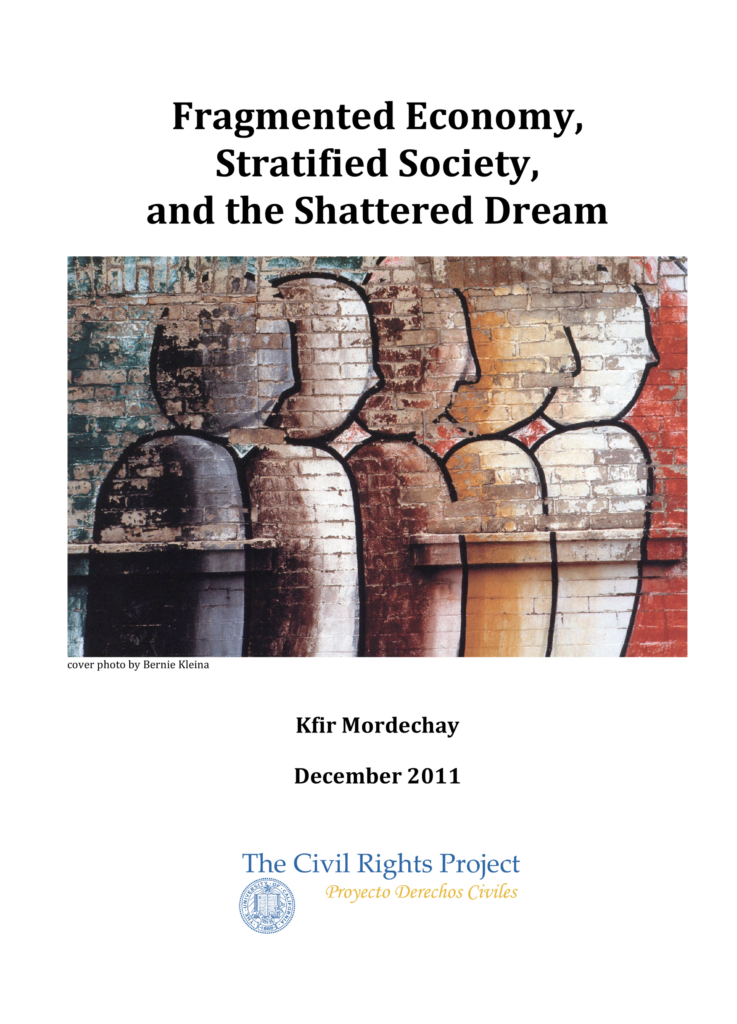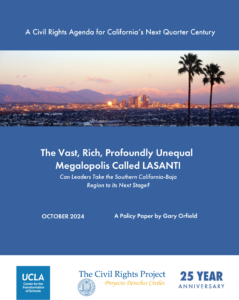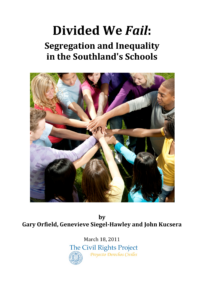Executive Summary
Across the massive megalopolis we call LASANTI, stretching from the northern suburbs of Los Angeles County, through the metropolitan complex along the northern border of Baja California, is a diverse area containing 24 million people, with a disproportionate percentage of Latinos and African Americans who are facing an educational and economic disaster. As it becomes increasingly evident that recovery from the most severe economic downturn since The Great Depression will remain subdued, and as the depth of economic plunge in The Great Recession becomes increasingly clear, it is essential to examine the growing disparities in the labor market which have resulted in a widespread increase in economic inequality throughout the region and the state. Though easily drawn into focus in this time of extreme economic slowdown, the changes to the Southern California economy over the last four years are only symptoms of an already existing structural problem exacerbated by the recession, not created by it. Furthermore, it is essential to understand the differential economic opportunity in the region, as it provides a telling story of the challenges we face throughout the nation. If we are to address the state and the nation’s growing economic inequality and emerge from this recession better and stronger, it is imperative to gain a better understanding of the highly diversified labor market, and the differential nature of opportunity.
This report shows that for several decades there has been a trend towards differential educational and employment opportunity, and that these social and economic inequalities have been heavily related to racial, ethnic, spatial, and social class distinctions. Individuals from the lowest social rungs, particularly Latinos, African Americans, and those in the lowest educational ranks, not only begin with different opportunities and resources, but often do not have the paths to mobility in the quest for social and economic well-being. This trend of racial and class stratification in terms of employment prospects, earnings, and educational opportunity has been increasing for the last 30 years.
The following report reveals the depth and scope of the problem, with the hope that it will be instrumental in focusing attention on the remedies and leadership needed to make real changes, so that all groups can benefit from the opportunities available within our communities.
Rising Inequality in California
Income Stratification: The gap between the haves and have-nots has significantly widened in the state, as the majority of the state’s residents have experienced downward mobility. In California, the widening gap in inflation-adjusted income has been more severe than in the U.S. as a whole. Since 1979, high-wage California workers reported earnings that were substantially higher than their counterparts across the nation. However, while middle wageworkers have barely kept pace with inflation, California workers on the lowest end of the wage distribution scale have lost purchasing power as their inflation-adjusted wages have dramatically declined since 1979. More specifically, the data reveal that:
• After adjusting for inflation, high-wage Californians’ hourly earnings from 1979-2006 increased by 3.7 percentage points higher than that of similar U.S. workers.
• For workers at the middle of the wage distribution, wages have barely kept pace with inflation, and have been 3.6% lower than typical middle-wage workers in the U.S.
• Workers on the lowest end of the wage distribution scale have lost purchasing power as their inflation-adjusted wages have dramatically declined since 1979. California’s low-wage workers have seen a decline of 7.2% in wages since 1979, contributing to a substantial decline in purchasing power. In comparison, in the U.S. as a whole, low-wage workers have experienced gains of 4%.
• Statewide personal income plunged 2.5% in 2009, accompanying a nationwide drop of 1.7%.
Job Stratification: Since 1980, both low-wage and high-wage jobs have been created in the state, with substantially fewer jobs created in the middle of the income distribution of wages. Moreover, California’s job growth was considerably more concentrated at each end of the earnings distribution during the 1990s and early 2000s than it was in the 1980s. Key findings from this study show that:
• 70.3% of jobs created in the state between 1989 and 1999 had hourly earnings in either the bottom fifth or the top fifth of the earnings distribution scale, showing a higher intensity of economic stratification than figures from the 1979-1989 time period where 45.5% of jobs created were in either the top fifth or the bottom fifth of the distribution in California.
• More than one in three (37.1%) jobs added in the 1990s were in the bottom fifth of the earnings distribution, more than twice the amount added in the 1980s (18.5%).
• One in three jobs created (33.1%) during the 1990s was in the top fifth of the earnings distribution scale, compared to 27% during the 1980s.
• The trend further intensified in the period from 1999-2005, when almost 69% of all jobs created were in either the lowest or highest end of the earnings distribution scale.
The Great Recession and the Acceleration of Inequality: Technically, The Great Recession is over. Yet, its aftershock is still being felt across the nation, as communities continue to bleed economically. The official unemployment rate in Los Angeles County was 12.2% in October 2011, and would be significantly higher had many people not given up searching for work. This paper investigates the underemployment rates, which provide a more accurate picture of the battered job market. Data reveal that educational levels and race are highly correlated to underemployment rates.
• Underemployment rates since the onset of The Great Recession (2007) for workers without a high school diploma have skyrocketed by almost 19 percentage points (18.6%); for those with one, the rate jumped more than 14% (14.4%). Those with a Bachelor’s degree saw underemployment rates increase by 6.3%.
• Hispanics have seen underemployment rates skyrocket to just under 29% (28.9), 16 percentage points higher than in 2007. African Americans have seen their rates increase to almost 25% (24.8), an increase of 10.1% since 2007, while whites have seen an increase of 8% in underemployment rates.
Industry Losers: The rapid decline of the construction and manufacturing industries adversely impacts the life outcomes of many of the region’s residents, from labor market outcomes, such as employment, economic mobility, and earnings, to a broader array of social consequences. Particularly troubling is that an immense majority of those who work in the construction industry in Los Angeles County are Latino, and many of them come from neighborhoods of concentrated poverty. These circumstances render many jobless in an economic abyss.
• Over 59% of construction workers live in Los Angeles neighborhoods of concentrated poverty.
• The ethnic make-up of the construction workers in neighborhoods of concentrated poverty throughout Los Angeles is: 88% Latino, 4% Black, 4% Asian, and 3% white.
• Many Latinos employed in the construction industry have low education levels and limited English, making it very difficult to find employment that requires a formal education.
Policy Recommendations
The policy landscape is already deeply divided with widely different proposals about what, if anything, should be done to fix the severely feeble economy. What this research reveals is that the ‘California Dream’ has been eroding for the majority of residents at an increasingly intense pace for several decades now. Policies that generate more widely shared prosperity will lead to stronger and more sustainable economic growth. This report recommends several policies to help combat growing stratification in Southern California, including customized job training, government investment in infrastructure, targeted tax credits, addressing China’s currency revaluation, and addressing educational inequality. Complacency is likely to lead not only to enhanced inequality and increased social marginalization, but also to prolonged economic stagnation in California and the nation.
This paper is part of the LASANTI Project, which explores many dimensions of social and economic change and inequality across the huge bi-national urbanized complex, stretching from the northern Los Angeles suburbs down through San Diego, to the Tijuana metropolitan area.
See a full description of The LASANTI Project here.
In compliance with the UC Open Access Policy, this report has been made available on eScholarship:





